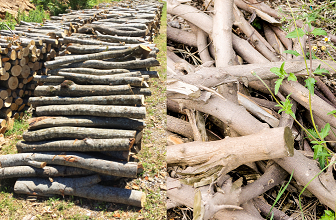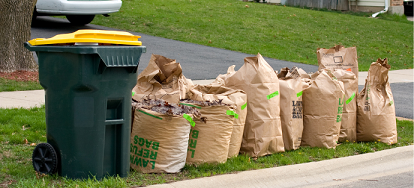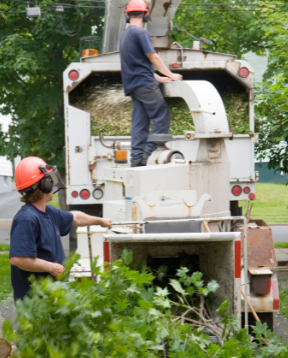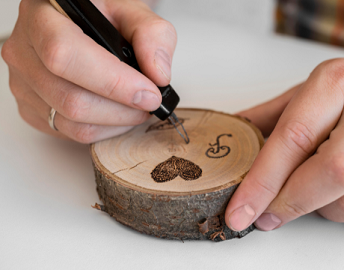
Landscape Waste Definitions and Regulations
The Illinois Environmental Protection Act prohibits the disposal of landscape waste in landfills. Instead, landscape waste is collected both by waste haulers and landscaping contractors and transferred to special facilities where it is ground into mulch or processed into compost. State law defines landscape waste as grass and woody trimmings, leaves, tree limbs, and other materials resulting from the care of lawns, shrubbery, vines and trees.
In practice, landscape waste is divided into two segments with somewhat different disposal options: yard waste and brush.
Yard waste includes grass clippings, weeds, leaves, pine needles, plant stems, flowers and smaller twigs and branches. Yard waste does not include whole potted plants, clods of dirt, houseplants, straw bales, or sod. It's also important to make sure that yard waste put out for composting is free from plastic pots, plant tags, plant stakes, wire plant cages, etc.

Brush is woody debris, including larger tree and shrub branches or limbs.

Yard Waste Disposal
Curbside Collection: Almost all municipal waste hauling agreements include a yard waste program. Generally speaking, these programs run from April to November, but residents should check with their hauler and/or municipality because some programs start in March and some extend into December (see links to the right). Most programs also include a special collection in January for live Christmas trees.
Packaging for Curbside Collection: All curbside programs allow residents to place yard waste in two-ply, wet strength paper bags sold at grocery and hardware stores. Items that can't practicably fit into bags, such as long sticks/branches or vines can be tied into bundles using biodegradable string or twine, not wire. Check with your hauler for exact bundle specifications, but generally they should be not more than 4 feet long or 50 lbs. in weight. Residents are often allowed to place yard waste for collection into their own clearly labeled tote or container, provided that it is 33 gallons or less in size, has handles, and weighs less than 50 lbs. when full. Some municipal programs have 65 or 95 gallon cart rental options for yard waste. Finally, some municipalities and townships conduct fall curbside leaf collection with a vacuum truck, so leaves can be raked to the curb loose. Check with your municipality for more details. Yard waste should never be placed in plastic bags, mixed with trash or recycling, or swept into roadways.

Drop offs: See list here.
Burning: Residents of municipalities should check their local ordinances. Burning of dried out landscape waste is allowable in unincorporated areas of certain rural zip codes only, and only under certain weather conditions. See Kane County's Burn Regulations for details. Landscape waste should not be burned wet or damp.
Costs & Cost Reduction: Some municipal programs include the cost of yard waste collection in the base rate for trash. Others require that each bag, bundle or 35 gallon container have its own trash or special yard waste sticker. Costs at drop-offs are at the discretion of the operators. Residents can save money on landscape waste disposal by mulching leaves and grass clippings into their lawns and by composting at home! If planting a new tree, consider something slow-growing and strong, like a native oak, which will produce a lot less litter than many fast-growing ornamentals, acorns not withstanding. Seedless varieties of notoriously messy trees like honey locust or Kentucky coffee tree may also be desirable. Pressed, dried leaves, twigs, acorns, and dried seed pods can make fun craft materials for kids and grown ups too (see "Fun with Brush" section below for some ideas).
Brush Disposal
Brush Collection: Municipalities and townships often provide pick-up programs for larger woody debris. These services may be available on a seasonal schedule, upon request, or following destructive weather events. See the bottom set of links at right for more information. If there is no link for your place of residence and your trees have sustained storm damage, call your township or municipality to see if there are short-term debris services available.
Professional Tree Services: When a tree on private property is damaged by a storm, disease or age, it is a good idea to have a professional come out and assess its condition, especially if it is close to any roads or structures. Check to see if local tree professionals can provide chipping or hauling service to dispose of limbs. If scheduling a whole tree removal or substantial pruning, it is not a good idea to get service without cleanup included unless you have a plan for disposal.

Burning: Residents of municipalities should check their local ordinances. Burning of brush (dried wood from shrubs and trees) is allowable in certain unincorporated zip codes under certain weather conditions. See Kane County's Burn Regulations for details, and please be mindful of your neighbors!
Fun with Brush: Sticks, twigs, and even larger branch cuttings can be materials for some really cool functional and decorative upcycled crafts. Here's a YouTube search for some inspiration, and blog posts for a colorful fall-themed mobile, a wall hanging, a rustic stool, a colorful vase display, Christmas/winter themed projects, and kids' crafts.
